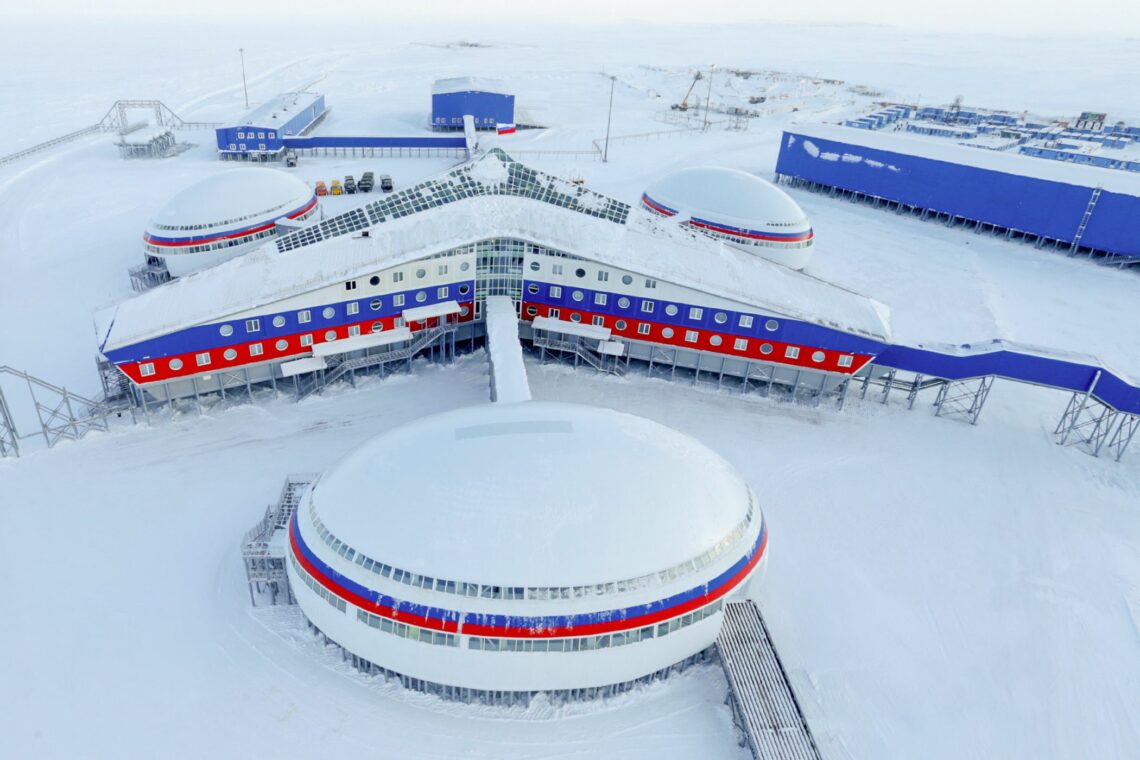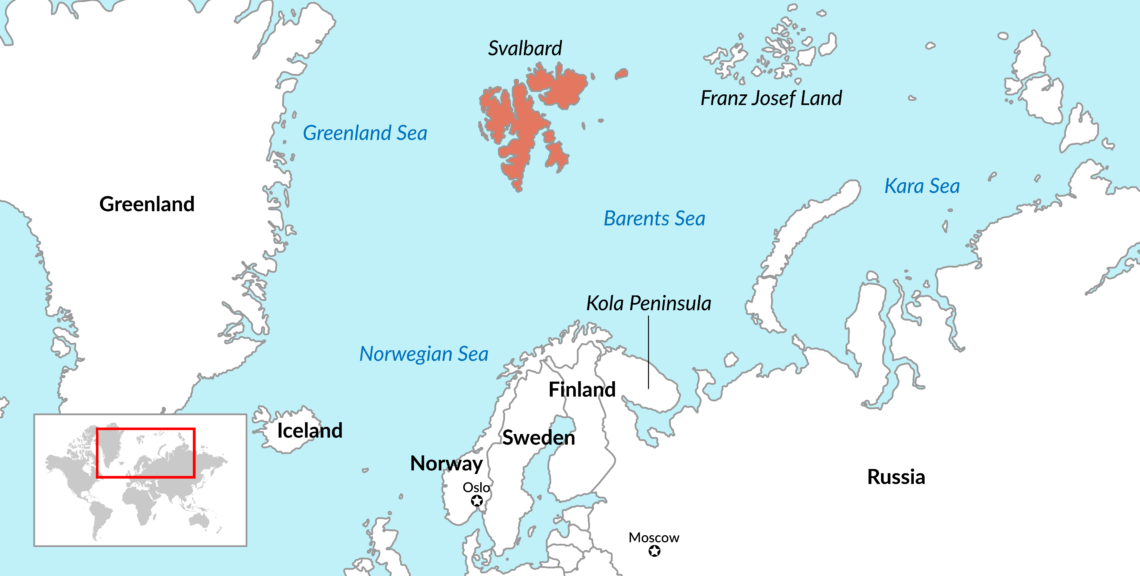Norway and Russia clash over Svalbard
The Svalbard archipelago has become an unexpected source of tension between Norway and Russia, with Moscow accusing Oslo of restricting access to the islands. The two countries could opt to collaborate more closely and jointly explore oil and gas resources in the region.

In a nutshell
- Russia has accused Norway of restricting access to Svalbard
- The two countries could join forces to exploit resources
- However, Moscow’s aggressive approach could cause clashes
The steady rise in tensions between Russia and NATO is about to find a new and unexpected outlet. The remote Svalbard archipelago, situated halfway between mainland Norway and the North Pole, could become an unlikely flash point as Moscow and Oslo gear up for resource extraction.
Rising temperatures are causing the Arctic ice cap to melt, leading to vast new opportunities for oil and gas exploration. And, as the Arctic grows in economic importance, countries in the region are building up their military presence.
Terra nullius
The game for the Arctic has attracted unlikely players, like China, and seen unusual policy plays, like President Donald Trump’s offer to purchase Greenland from Denmark. But the main actors are Russia and Norway. It is in their respective economic zones that the bulk of undiscovered oil and gas may be found. The Russian Northern Fleet must also sail through Norwegian waters to reach the Atlantic.
Having long been terra nullius, the status of the Svalbard archipelago was defined by the Spitsbergen Treaty of 1920, later renamed the Svalbard Treaty. Ratified in 1925, it awarded sovereignty to Norway under strict conditions. The archipelago was to remain a demilitarized zone, with no permanent military presence allowed. All parties to the treaty (presently close to 50) were to have equal rights to commercial activity.
During the 1980s, Moscow decided to invest in its Arctic presence.
The strategic importance of Svalbard was made clear during World War II, when it served as a refuge for German submarines harassing allied convoys bringing supplies to Murmansk. The postwar era has been uneventful. The present population is just shy of 3,000, on par with the estimated number of polar bears. Norwegians form a slight majority, and the remainder of the population comes from various other countries.
Aside from its administrative presence at Longyearbyen, Norway’s involvement has amounted mostly to meteorological observation and operating the Svalbard Global Seed Vault. Housed deep inside a mountain, the latter is a secure backup facility for global crop diversity. Norwegian coal mining at Sveagruva and Luckerfjellet was suspended in 2017 and closed for good in 2020.
Facts & figures

The only other country with a serious interest in Svalbard is Russia, and its ambition has been to maintain a geopolitical foothold on the archipelago. In 1927, the Soviet Union bought the Pyramiden coal mine from Sweden, and in 1934 it acquired the Barentsburg coal mine from the Dutch. Run by the state mining company Arktikugol, the two became classic Soviet-era “company towns.”
During the 1980s, Moscow decided to invest in its Arctic presence and Pyramiden experienced a revival. By the end of the 1980s, around 1,000 people lived and worked there. Today, it is a ghost town that attracts a trickle of tourism. With its twin town at Barentsburg, where the mine still operates, it serves as an outdoor museum.
Although the economic importance of its operation on Svalbard has long been on the decline, the Kremlin likely believes that its efforts to retain a foothold will soon pay off. Throughout 2020, which marked the centennial of the Spitsbergen Treaty, a flurry of communication between Moscow and Oslo showed that the status of the territory has been moved to the top of the Russian agenda.
Disputed access
In a letter to Norwegian Foreign Minister Ine Eriksen Soreide, sent only days before the treaty’s anniversary, Russian Foreign Minister Sergey Lavrov voiced concerns about alleged discrimination. The Kremlin claimed that Oslo had been seeking to limit Russian activity in the area, against the treaty’s guarantee of “equal liberty of access.” Specific complaints included the creation of fishery protection zones, which Norway views as ecological measures; interference with Russian helicopter flights over the region; and changes in deportation rules targeting Russian citizens. Moscow requested bilateral consultations to address the matter.
The situation could now evolve in two fundamentally different directions: increased commercial cooperation, or heightened military confrontation. The former scenario would stem from the resolutions established in the 2010 treaty on Maritime Delimitation and Cooperation in the Barents Sea and the Arctic Ocean between Norway and Russia. Then, faced with the prospects of massive commercial gain from offshore oil and gas exploration, the two sides had decided to resolve a four-decade dispute by simply drawing a line down the middle of the contested area.
The 2010 agreement stipulates that any discovered oil or gas reservoirs that extend across the line of demarcation must be developed and exploited jointly. For example, the recently discovered Norwegian field Stangnestind is believed to extend into the Russian side. In the words of Norwegian energy expert Kjell Giaever, Director of Petro Arctic, “The entire energy world will turn its eyes to the north if large cross-border discoveries are made here. As for potential ripple effects, it is not without complications.”
Russia has recently made several moves clearly aimed at Svalbard.
Russia is bound to respond to any discoveries in this field by drilling appraisal wells on its side, and any potential Russian discoveries along the demarcation line will prompt Norway into similar exploratory drilling. If a major common reserve is found, it will open vast opportunities for joint ventures involving both energy companies and service providers.
This scenario is made less likely because of the continued Western sanctions against Russia, imposed in response to its aggression against Ukraine. Faced with the threat of serious penalties, Western energy giants like ExxonMobil opted to withdraw from projects for joint exploration of the Russian part of the Arctic that could have been highly lucrative.
If some way to roll back those energy sanctions could be found, it would provide opportunities for players like ExxonMobil and Norwegian Equinor (formerly Statoil) to engage with Russian partners in exploring Arctic hydrocarbons. Given that the Russian partners would have close ties to the Kremlin, the prospect of massive profits would defuse the risk of military confrontation.
An even more formidable obstacle to this scenario is opposition from various environmental groups protesting Arctic exploration. As Norway has proceeded to open blocks in the High North, it has even been faced with a legal challenge, alleging a violation of the country’s constitution. Although the court rejected the claim, the issue remains controversial.
Military pressure
The alternative to commercial cooperation is military confrontation. Svalbard is a logical component of Russia’s ongoing militarization of the Arctic, which has entailed establishing military bases along its northern coast. Notably, the large Trefoil air base on the remote archipelago of Franz Josef Land is located only 260 kilometers to the northeast of Svalbard.
Russia’s recent deployment of state-of-the-art Borei-class ballistic submarines has placed added emphasis on the need to protect the basing areas for the Northern Fleet on the Kola Peninsula. For this purpose, in 2015 a special-purpose Arctic brigade was organized, which has since received state-of-the-art transport and weaponry. Located at bases close to the Norwegian and Finnish borders, it has conducted major military drills in Arctic warfare. The Russian Navy has also conducted missile firings off the coast of Norway.
NATO has proceeded to counter this mounting threat to its northern flank, with Norway taking center stage. In October and November 2018, it was home to Trident Juncture, with some 50,000 troops from 31 NATO and partner countries. In March 2020, it hosted Cold Response, in which 16,000 soldiers from 10 different countries honed their skills in multinational joint operations under demanding Arctic conditions. And in March 2021, U.S. Marines joined Norwegian forces in the Arctic Littoral Strike exercise.
The alternative to commercial cooperation is military confrontation.
In a worst-case scenario, Russia would move to seize the demilitarized Svalbard and transform it into a forward outpost for its Trefoil base on Franz Josef Land. By rapidly introducing radars and missile batteries, it could create an A2/AD (“anti-access/area denial”) bubble like those in Crimea and the Kaliningrad exclave, which control access to the Black Sea and to the Baltic Sea, respectively. This would give NATO a serious strategic disadvantage.
Russia has recently made several moves clearly aimed at Svalbard. Its 2016 security doctrine mentions it as a potential war zone for the navy, together with Crimea and the Kuril Islands. The September 2017 Zapad war games allegedly featured a simulated air attack against Svalbard, demonstrating that Norwegian fighters would be unable to fend off a surprise airborne landing. The event is said to have taken NATO by surprise and to have raised serious concerns over intelligence failures, although all sides deny the incident took place.
In April 2018, a group of Chechen special forces en route to an airborne drill near the North Pole used the Longyearbyen airport to transport both troops and equipment. And in the fall of 2019, Russian Special Operations Forces made a brief appearance under cover of night.
These military provocations likely mean that Russia’s ambition is to push Norway into accommodating its economic interests. In his 2020 letter to his Norwegian counterpart, Foreign Minister Lavrov announced that Russia has long-term plans for its presence on the archipelago. Given that coal deposits are running out, the only conceivable interpretation is that Moscow wants access to the continental shelf.
The Kremlin will find that Norway is not easily intimidated.
In March this year, Russian Foreign Ministry spokeswoman Maria Zakharova again lashed out at Norway, claiming it has no right to explore the shelf around Svalbard for oil and gas. Some of the new blocks were alleged to be part of the zone regulated by the Svalbard Treaty.
Norway rejects such calls, claiming that the treaty provisions apply only to the land area and to the adjacent territorial waters. Waters outside the 12 nautical miles coastal zone form part of the continental shelf of mainland Norway and should be governed by the 1958 Continental Shelf Convention.
Although Russia is not alone in contesting the Norwegian claim, its use of military pressure to force economic concessions means the stakes will be high. But the Kremlin will find that Norway is not easily intimidated. Playing the military card will inevitably provoke NATO into responding.







